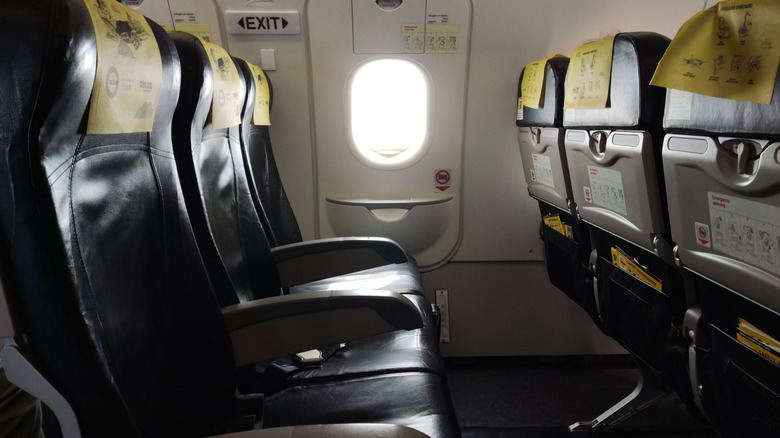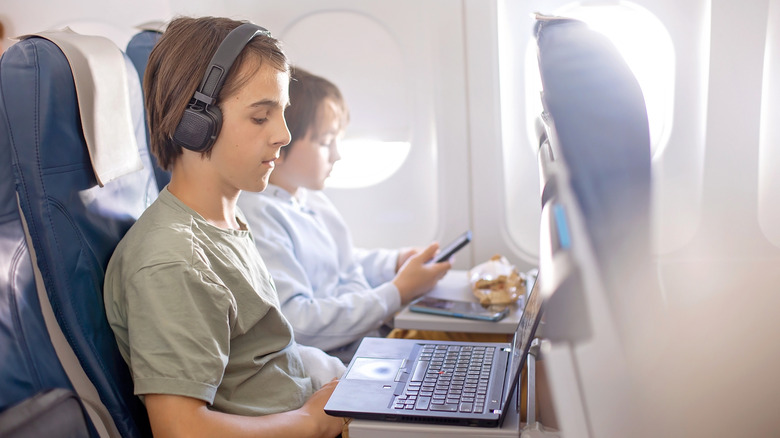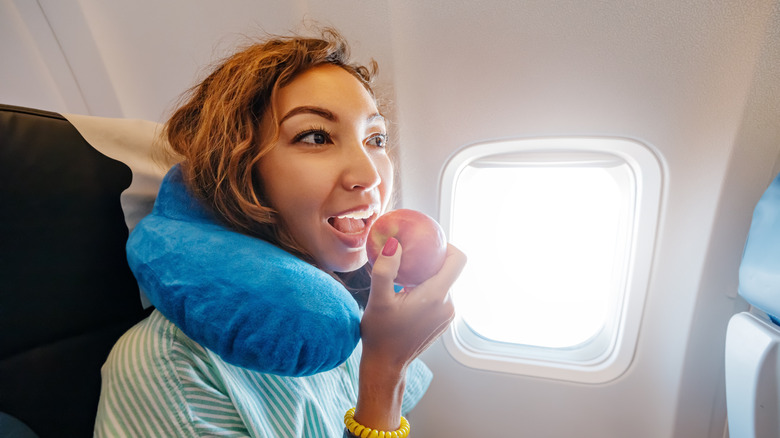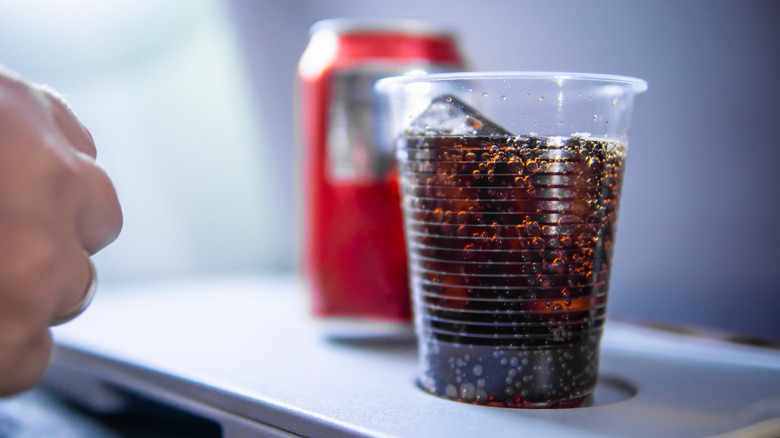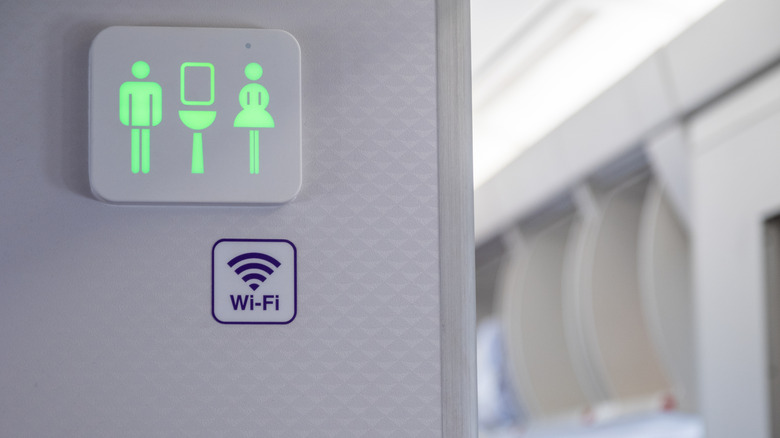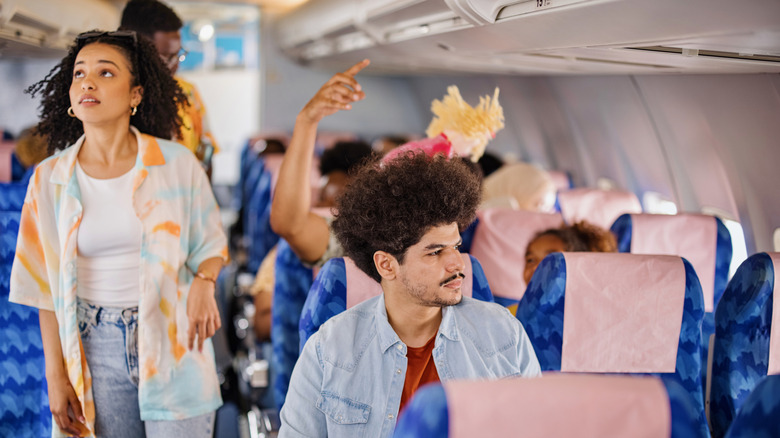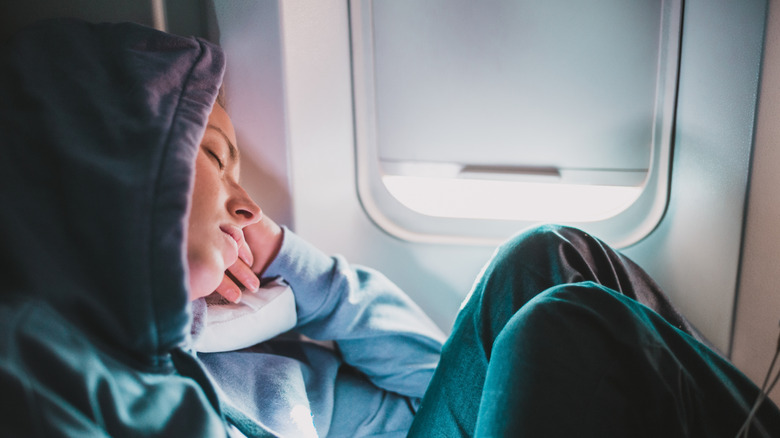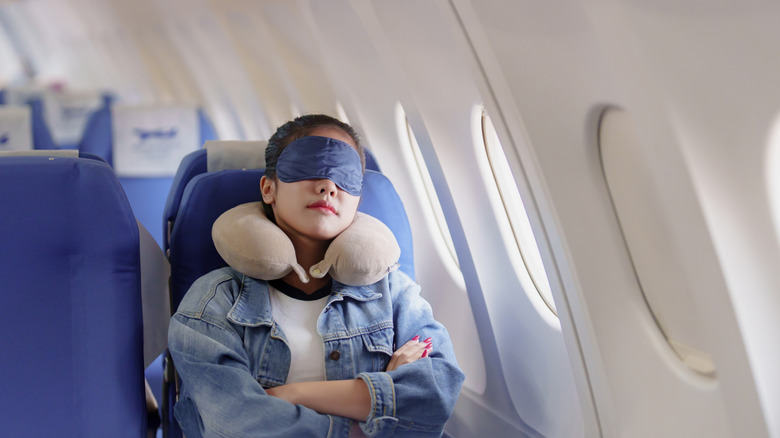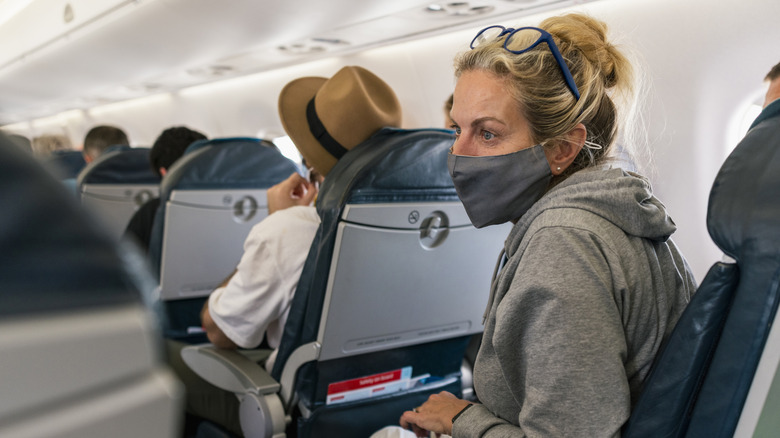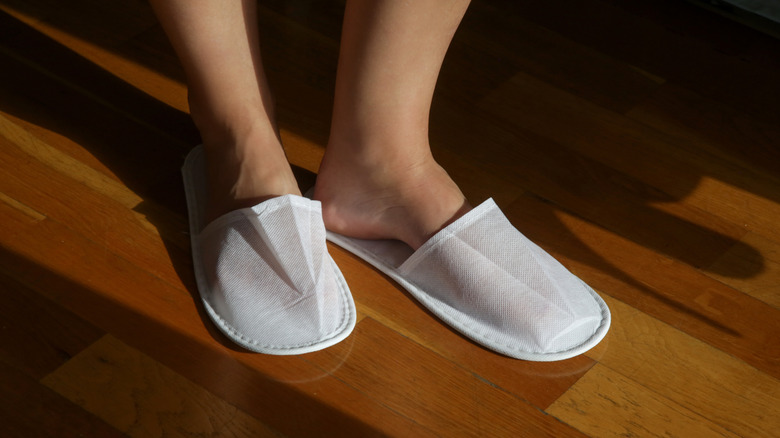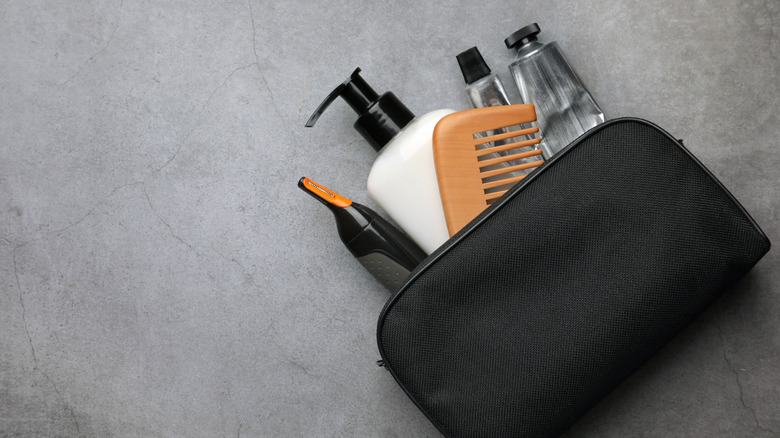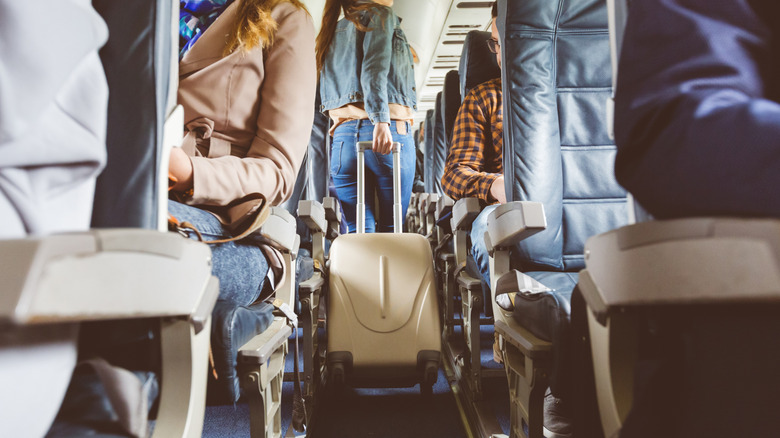14 Tips From Flight Attendants For Surviving Ultra-Long-Haul Flights
Ah, the wonders of flying. There really is an undeniable pleasure in boarding an aircraft in the knowledge that, a few hours later, you will arrive in a totally different environment, like a hidden tropical paradise. Even for novice fliers, short flights are pretty easy to handle. Often the plane is up and barely coasting before it's time to start the descent. You can use the time to have a brief siesta, catch up on the latest episode of your favorite series, or push through a chapter of a novel.
But for more protracted journeys, like some of the longest flights in the world, making that seemingly infinite time in the air pass can feel like actual torture. You have to endure the challenge of feeling cooped up in a confined space or the tedium of keeping yourself entertained for hours on end. Luckily, Islands has the inside scoop on how to make your next ultra-long-haul flight (12 hours or more is a common definition) more bearable. We interviewed a couple of flight attendants — Janna Barrett and Johanna (who prefers to go only by her first name for the purposes of this story) — who each have about a decade of experience in the sky. These two are seasoned professionals when it comes to surviving long hours in the air, and if you apply their shared wisdom, you can become one too.
1. Book the right seat
Whatever you might think, every seat is not created equal. Obviously, there are different classes within an aircraft, and there are even differences between business class and first class, even if that isn't readily apparent. But within economy, which is the type of ticket that we will concentrate on, the seats do vary. As Johanna notes, "The biggest factor contributing to misery on the aircraft is unfortunately the most difficult to fix, and that's lack of space and comfort." That is most directly related to the seat because that is where passengers spend most of their time. "Opt for an exit row when possible, as these rows typically have a few more inches of legroom," Johanna advises. "Same with the bulkheads, or the first row of a seating section that faces a wall. Choosing these areas in the plane can afford a bit more space without requiring a pricey upgrade."
Janna Barrett, who works for a major commercial airline and is also a writer on Medium.com, suggests a clever hack for making economy more bearable. "I met a passenger who said that when a lie-flat seat is either unavailable or out of budget, he books three adjacent economy seats. It's still more affordable than one seat in the premium cabin, and it allows him to stretch out and get some rest." However, Barrett does warn passengers against certain economy seats. "Any row with its back immediately in front of a window exit will have the recline function disabled on its seats. Most airlines let you see where your seat is on the map before booking your ticket, so if reclining is important to you, confirm that."
2. Bring your own entertainment
Onboard entertainment has grown leaps and bounds since the days when passengers had no choice but to watch the one film broadcast on a plane via screens that were dotted around the cabin. Nowadays, you can choose from a plethora of entertainment options, like movies and TV shows to games and music. You can also pause a show in case you need to visit the restroom or take a short nap, and pick up where you left off minutes later. On some flights, Wi-Fi is even available. And yet, sometimes those interfaces don't function quite as seamlessly as they should. "There is the potential for a lack of entertainment if you rely on the airline — both television and Wi-Fi can be unreliable, and some Wi-Fi systems are unable to operate over water," explains Johanna.
There are also times when you have the bad luck of having the only screen in the whole aircraft that doesn't function. "As a passenger, I recommend bringing something to occupy yourself that doesn't require the in-flight entertainment system," Johanna continues. "Bring a physical book or a game you can play with a fellow traveler. Make sure to download content like e-books, TV shows, and movies to a tablet or personal device in the event that Wi-Fi isn't available." She also recommends packing headphones — a noise-canceling pair is the most effective to counteract the various sounds of a flight — and a power cord so that you can charge your device on the plane.
3. Think about staying up before the flight
Sometimes watching a movie on a plane, either on the plane screen or on your own device, can strain your eyes. And playing cards with the person in the seat next to you just doesn't cut it. In fact, sometimes during a flight, the only thing you really want to do is catch up on all those hours of rest you missed because of late nights and early mornings caused by work, school, or family. For some passengers, sleeping on an aircraft is extremely hard. At least it is if they aren't exhausted, which is why staying up late the night before a flight might be the perfect preparation for your body before the airborne marathon.
If your body is really frazzled, all you might need to do is slide into your economy seat and drop into deep slumber. Johanna recommends this as a good option for killing a few hours. "Another way to pass the time is to sleep, and if you plan to do so, it may be a good idea to book a window seat." By booking this kind of seat, she notes, you can lean on the wall along the side of the aircraft, and you won't be disturbed by other passengers in your row needing to exit to use the restroom or stretch their legs. If you plan to sleep, bring the right gear. "Travel pillows and noise-canceling headphones are also helpful sleep aids when traveling."
4. Pack food
For ultra-long-haul flights, you might receive two or more meals and possibly snacks at various points during your time in the air. What you won't enjoy is an open buffet to choose from whenever your heart desires. As a result, Janna Barrett notes, you run the risk of "being hungry or thirsty during times when there's no service happening." Plus, not everyone will eat the airline food. Gordon Ramsay certainly won't touch it. To combat this possible nightmare scenario — a growling stomach somehow feels worse when you are 40,000 feet in the air in a pressurized cabin with no stores in sight — Barrett suggests packing snacks. "Trail mix and protein bars are great because they don't need to be kept hot or cold, and it doesn't matter if they get a little squished in your bag. Plus they're generally fine if you're going through customs."
Johanna concurs, adding that "no one wants to be hangry on a long-haul flight." She recommends protein-rich snacks like hard-boiled eggs, yogurt, or cottage cheese, "because they keep me full for longer." One thing you should also do is eat lightly beforehand because a heavy meal before the flight can make you feel uncomfortable. An emptier stomach also allows your digestive system a break before it adjusts to a new time zone.
5. Don't drink sodas
If you have ever taken a packet of chips onto a plane, and then halfway through the flight gone to open them, you will probably remember what you saw. The packet mysteriously popped out like a freshly plumped pillow. That is because an air cabin is pressurized to allow passengers to feel comfortable and have enough oxygen in the cabin environment to breathe easily. One side effect of that pressurization is that it expands air, including the pockets of air inside that chip packet.
It will also expand the air inside your stomach and intestines, which is why many passengers feel icky and bloated onboard (some mitigate this by undertaking the practice known as crop dusting as they walk down the aisle). One way to reduce those feelings of unease is to not introduce any more gas into your system unnecessarily. So, as Janna Barrett advises, "Avoid drinking anything carbonated. This mitigates the discomfort and bloating you'll experience from the air in your body expanding at altitude." If you are really thirsty, water is always the best option.
6. Use the restroom early
As we have explained, air has a sneaky way of silently altering its dimensions within the cabin. Air that is trapped within you will inflate, like a balloon that wants to be released but that is sadly imprisoned under skin and flesh. As a result, you will suffer. You can help your unfortunate situation by using "the restroom as soon as possible [when the seatbelt sign is off]," as Janna Barrett suggests.
"The cabin is pressurized, but the decreased air pressure at that altitude means all the air in your body expands a little. So the sooner you can get things out of your system, the less discomfort you'll experience." One easy option is to hit the restroom as soon as you board, before the plane doors are closed, and then again shortly after takeoff, but only when it is safe to do so.
7. Move around the cabin
Sitting in a seat for hours on end during an ultra-long-haul isn't just boring. It is also bad for your health and can lead to blood clots, stiffness of muscles, and painful cramps. That is why passengers should get up frequently. "Don't stay seated the whole time," explains Johanna. "You'll want to wait for the appropriate time to get up and stretch your legs [when the seatbelt sign is off], but it's important to do so." She stresses that walking up and down the aisles, which might look strange, is fine to do, but fliers should not try to do it when the crew is serving food or drinks. Passengers also shouldn't crowd around toilets or in the galley areas where the crew prepares food and snacks.
Janna Barrett notes that remaining seated for long stretches can be inconvenient, especially if you need the bathroom, and you might not want to disturb the person in the aisle if you are seated by the window. But staying put is no solution. "Give your body a break," says Barrett. "Get up and walk around every hour or two as long as the seat belt sign is off. Stretch a bit, wiggle your ankles." One thing to consider, notes Johanna, is that if you plan to get out of your seat frequently, book an aisle seat and not a window seat (the one place a passenger can enjoy a long bout of uninterrupted sleep).
8. Hydrate constantly
Another by-product of flying at high altitudes way above the humidity of the sea is that the air is very dry. That arid air is the source of your cabin's air, and if there is less humidity in it, there will be less humidity in the air that circulates around the cabin. Passengers will often feel parched on a flight, and the most obvious way to combat those "dry conditions in the cabin," Janna Barrett relays, is to drink water. "Bring a water bottle. [Only fill it after you go through security, though. Otherwise, you'll have to dump the liquid or surrender the bottle, due to security regulations.]"
Drinking water, however, isn't the only way to redress the imbalance in your body's moisture though. Barrett points to a more rounded approach that looks at all the effects of the dry cabin. "Besides drinking water, I keep my body and skin hydrated." She suggests bringing lip balm, hand lotion, and a facial spray.
9. Dress smartly
To take an ultra-long-haul flight, you need to prepare for an assault on many of your creature comforts. For starters, as Janna Barrett reminds us, "The cabin is generally pretty cold, and blankets might not be available." So, passengers should wear clothing that can keep them warm in frigid conditions. We aren't suggesting dressing for winter, but definitely wear a sweatshirt, a fleece, or a hoodie, maybe even a woolen hat that scrunches down to a small size and is easy to pack. "For added comfort, consider bringing a neck pillow and a sweater or blanket," Barrett suggests.
Wear loose-fitting clothing so that you can move freely, both within your seating area and around the cabin. Sometimes, you will need to twist yourself like a pretzel to find a position that is comfortable in your seat, so definitely avoid these things you should never wear on a plane. Blood clots and deep vein thrombosis are very real concerns on these long flights, but there are ways to help combat them. "I wear compression tights to help with blood circulation, which mitigates fatigue," explains Barrett. "There are also compression socks and/or pants for both men and women."
10. Carry an eye mask, ear plugs, and neck pillow
Unless you have a suitcase full of spare cash and can spring for a business-class seat on your next ultra-long-haul flight, you are going to be stuck in economy. And this means you won't have much space to unwind, relax, and recharge. With the noise, light, and position in which your body will be crammed, reveals Janna Barrett, it can be "difficult to sleep." But you can make those restrictions feel a whole lot less restrictive by taking along a few simple items.
"Bring an eye mask and earplugs [or headphones] to block out light and noise. That will make it easier to sleep." Flights are not always enjoyable, and for some passengers, the key to tackling ultra-long-haul flights is to block out as many aspects of the flight as possible while still traveling through the air. This means silencing the noise, cutting out the light, and making a hard, barely movable seat as comfortable as possible.
11. Pack a face mask
While the thought of this might make some passengers squirm, the reality is that any given plane is filled with hundreds of strangers and their own unique fragrances. This can range from seatmates who have questionable personal hygiene practices to fliers with overpowering perfumes and colognes. Sometimes, it is a person's food whose strong, powerful scent might seem heavenly to its eater but hell to everyone else. As Janna Barrett points out, passengers will encounter "possibly some unpleasant odors."
There is also the frequently committed act of crop dusting on a flight to deal with, proponents of which will defend it with the maxim, "better out than in." For help with any noxious fumes onboard, you could think about bringing a spritz to spray into the air to combat any stenches. Then, however, you might become part of the problem, not the solution. A better option is to "consider bringing a face mask," reveals Barrett. "Not only does it help protect against airborne germs in a closed environment, but it can also help mask odors."
12. Bring slippers
Another smell that has a way of quietly permeating throughout a cabin is smelly feet. "Some people remove their shoes during the flight because they're more comfortable that way," notices Janna Barrett. "If you choose to do so, wait until after takeoff, and put them back on before landing. If anything goes wrong, those are the times you'd need to evacuate. You want to be ready, and you want your feet to be protected from debris." While you yourself won't have smelly feet — of course you don't — as a courtesy to other passengers, wearing slippers will help to leash any foot odors while you pad around the cabin.
It will also, as Barrett notes, "keep your feet dry if there is liquid on the floor somewhere." Such soggy conditions might be found in the restroom, in which case the liquid on the floor won't necessarily be just water. One smart idea is to bring the slippers that are common hotel freebies with you to wear on the aircraft.
13. Put together a landing bag
As your ultra-long-haul flight starts to wind down, you might feel like your body has been in a boxing match with a heavyweight champ. Your limbs ache, your eyes feel both dry and irritated, your mouth is parched, and your skin looks sallow. But you can easily pep yourself up with some simple fixes, as Janna Barrett outlines.
"I have a ziplock bag with breath mints, eye drops, and single-use face/body wipes. All of these things help me freshen up before landing. You could even use your travel-size deodorant or fragrance afterward." She explains that anything with a mint flavor will help passengers stay alert or wake up and that eye drops have a similar effect. The beauty of this mini-regimen is that you will leave the flight looking refreshed and recharged, as if you've just taken a short commuter flight, not traveled across the planet.
14. Be considerate
In the end, whatever preparations you make, the ultimate variable that you can never account for is other passengers. Their actions can make your flying experience so much easier, or they can break your spirit. So, try to set a good example and be respectful of other people, their space, and their journey. Hopefully, your example will rub off on others. "Be mindful that anytime you touch the back of someone's seat, they can feel it," explains Janna Barrett.
"You're entitled to adjust your tray table and put things in/out of the seat-back pocket, and you'll probably need to hold the seats for stability when getting in or out. But the person in front of you would appreciate you being considerate whenever you do." Simply put, treat others the way you would like to be treated yourself. Do that, and you might just come to love the experience of an ultra-long-haul flight more than you imagined possible.

